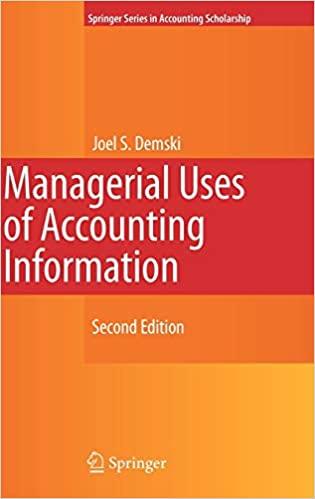12. framing and approximations This problem works through a sequence of framing exercises. (a) Ralph produces a
Question:
12. framing and approximations This problem works through a sequence of framing exercises.
(a) Ralph produces a single product, with quantity denoted x. Profit is given by the expression x(10−.5x), and capacity is constrained so 0 ≤ x ≤ 10. Determine Ralph’s optimal output.
(b) A new customer arrives on the scene. Let y denote the quantity of output Ralph produces for this second customer. This customer is a mirror image of the first, so Ralph’s problem is now to select quantities x and y to maximize profit of x(10 − .5x) + y(10 − .5y), but now subject to a capacity constraint of 0 ≤ x + y ≤ 10 (and nonnegative quantities of course). Determine Ralph’s optimal output of each product, i.e., x and y. You should find x = y = 5.
(c) Ralph likes to keep things simple, and enjoys working with single product decision frames. It turns out that the optimal x can be located in this case by maximizing any of the following functions:
(1) x(10 − .5x) + [50 − .5x2]; (2) x(10 − .5x) + [−.5x2]; or (3)
x(10 − .5x) + [−5x]. Verify this claim. Then carefully explain why each function allows us to identify the optimal choice of y.
(d) Now suppose Ralph must immediately decide on the quantity of the first product (x); after this decision has been implemented, Ralph will learn whether demand for the second product materializes.
If it does, and if Ralph supplies y units of the second product, total profit will be x(10−.5x)+y(10−.5y). Naturally, we require x+y ≤ 10. Let α denote the probability demand for the second product materializes. So Ralph’s problem is now to maximize expected profit of x(10−.5x) + αy(10−.5y), subject to a capacity constraint of 0 ≤ x + y ≤ 10. The solution is x = 10/(1 + α) and y = 10 − x. (x now denotes the immediate choice of first product quantity, and y the choice of second product quantity provided demand materializes.) How do you interpret this solution?
(e) Finally, go back to Ralph’s penchant for keeping things simple.
It turns out the optimal x can be located here by maximizing any of the following functions: (1) x(10−.5x)+α[50−.5x2]; (2)
x(10−.5x)+α[−.5x2]; or (3) x(10−.5x)+[−10αx/(1+α)]. Verify this claim. Then carefully relate each function to its counterpart in the initial story (where α = 1).
Step by Step Answer:






